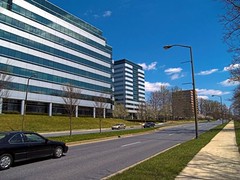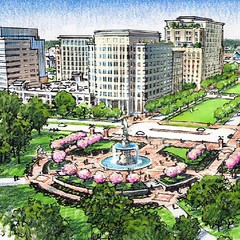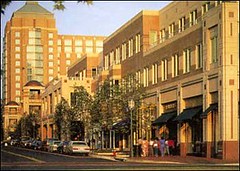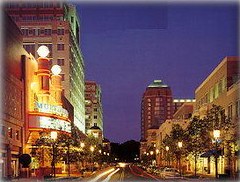Retrofitting suburbia for the 21st century (part 2: Columbia and Reston)

Posted October 8, 2008 at 2:53PM
As I wrote yesterday, environmental and economic forces are requiring that suburbs become more walkable, more transit-accessible, and more convenient than we have typically seen in the last 50 years. Yesterday we considered the new plan for Tysons Corner, Virginia, America's quintessential "edge city." Today we look at a plan to bring a major update to Columbia, Maryland, and a substantially successful similar makeover already being implemented in Reston, Virginia.
A real downtown for Columbia
At the initial plan's unveiling, noted developer James Rouse described Columbia as a planned new city that would avoid the leapfrog and spot development threatening Howard County, Maryland. The new city would be complete with jobs, schools, shopping, medical services, and a range of housing choices. Property taxes from commercial development would cover the cost of schools and additional services with which housing would otherwise burden the county. The planning process for Columbia included not only architects and planners but also a panel of nationally recognized experts in the social sciences. Today, although Columbia is a pleasant community in many ways, the reality has not entirely matched Rouse's ideals.
With 97,200 people, Columbia is now the second-largest "census-designated place" in Maryland (after Baltimore). Not an incorporated city, it remains a master-planned community rooted in the right idea, with tremendous vision, but with relatively little to show for it environmentally. For example, despite the presence of bus transit, Columbia remains very automobile-dependent: the average distance driven per day per household for vehicles owned by its residents (66.3 miles) is higher than the average for its metro area (61.9, for greater Baltimore) and twice that for residents of Baltimore city (32.4). Columbia is also surrounded by classic sprawl.
One of the more obvious problems is a downtown (of sorts) anchored not by walkable streets and mixed uses but by a large, enclosed regional shopping mall and surrounding parking. Office buildings are scattered around, as the images above show. But Columbia, too, is undergoing change.
The community's master developer, General Growth Properties, last week submitted an ambitious new plan to Howard County officials. As reported by Lori Aratani and William Wan in The Washington Post:
"Developers formally proposed the most ambitious overhaul of downtown Columbia in its history yesterday, hoping to transform the four-decade-old planned community into a collection of modern, walkable, environmentally friendly neighborhoods with a new downtown.
"General Growth Properties submitted a plan to Howard County officials that calls for 5,500 new townhouses and apartments and the construction of 1 million square feet of retail space over the next three decades in neighborhoods surrounding Columbia Town Center . . ."
The developer's transmittal letter to the county noted that Columbia's population is projected to grow 50 percent by 2040, 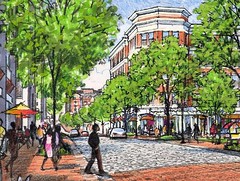 and the new plan proposes to absorb 20 percent of that growth in the downtown. In turn, 20 percent of the downtown component will be designated to meet below-market affordability standards, supported by a new Community Housing Foundation. The plan also recommends the establishment of a Transportation Management Association to coordinate multi-modal travel options, a downtown transit hub and, like the plan for Tysons, a tighter grid pattern of walkable, connected, "complete" streets. There is also a substantial "sustainability framework" that provides for green technology, and there is even a shout out to LEED for Neighborhood Development.
and the new plan proposes to absorb 20 percent of that growth in the downtown. In turn, 20 percent of the downtown component will be designated to meet below-market affordability standards, supported by a new Community Housing Foundation. The plan also recommends the establishment of a Transportation Management Association to coordinate multi-modal travel options, a downtown transit hub and, like the plan for Tysons, a tighter grid pattern of walkable, connected, "complete" streets. There is also a substantial "sustainability framework" that provides for green technology, and there is even a shout out to LEED for Neighborhood Development.
Let's wish them well.
Reston Town Center
Columbia's ambitions for a downtown have already been realized, to some extent, in another ambitious but flawed "new town" of the 1960s: Reston, Virginia.
Reston was conceived and initially developed by Robert E. Simon (note the initials), whose family once owned Carnegie Hall in New York. The idea was to create seven European-style, mixed-income villages of 10,000 residents each, with shopping and service amenities within each, along with a town center district having the density, vitality, and symbolic character of a city.
Simon's vision, like Rouse's, was laudable, especially for its day. And, had it been realized, Reston might never have needed a retrofit. But the initial development company ran into substantial financial difficulties and was sold. 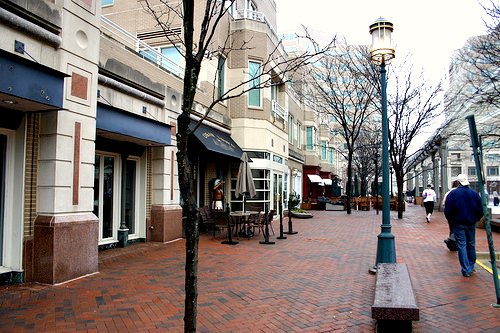 By the 1980s, Reston did have some pedestrian-friendly, village-like neighborhoods, but also substantial single-family, large-lot housing, plenty of automobile dependence, and no meaningful town center at all. (Today Reston is home to some 60,000 people, making it the most populous place in Fairfax County.)
By the 1980s, Reston did have some pedestrian-friendly, village-like neighborhoods, but also substantial single-family, large-lot housing, plenty of automobile dependence, and no meaningful town center at all. (Today Reston is home to some 60,000 people, making it the most populous place in Fairfax County.)
Reston's character finally began to change in the late 1980s and 1990s, when the then-owner (a subsidiary of Mobil, later of ExxonMobil) partnered with an experienced urban developer and hired enlightened planners and architects to tackle the town center. 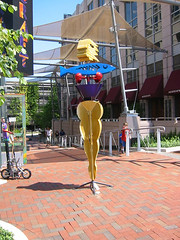 They made a decision to commit to an urban vision, and that vision has paid off. The new downtown opened for business in 1990 and is still being built out.
They made a decision to commit to an urban vision, and that vision has paid off. The new downtown opened for business in 1990 and is still being built out.
Today, Reston Town Center provides a much-needed heart to its community. With fountains, sculpture, a bustling restaurant scene, shops, apartments, offices, an ice rink, and hotels, the place is a real downtown, eminently walkable and filled with life year-round, especially on the weekends. While Reston unfortunately lacks rail transit, surveys indicate that the Town Center generates only half the automobile trips per day that a comparably sized but suburban-styled development would.
At least one writer has called Reston Town Center "the first suburban downtown in America." I don't quite agree, though it may have been the first new one. In either case, it has its own book (Reston Town Center: a Downtown for the 21st Century, Academy Press) which gives you a sense of its impact in the world of planning and development.
In a thoughtful 2006 essay in New Urban News, Philip Langdon reviewed the book and praised the development for its vision and success, but noted also that the town center lacked affordable housing and good civic spaces. I would add that, because Reston Town Center predated LEED and widespread adoption of green building and green infrastructure technology, it lacks some of the sustainability features that Tysons Corner and Columbia are likely to have. My verdict is that RTC is not perfect, but it has made a suburban community a heck of a lot better both for its residents and the environment.
Right now is a horrible time to be a real estate developer. But it's better to be a developer of lively, walkable, mixed-use town centers than a builder of sprawl. Expect to see a lot more suburban retrofits like these around the country as we learn from past mistakes and create communities for today's needs.

